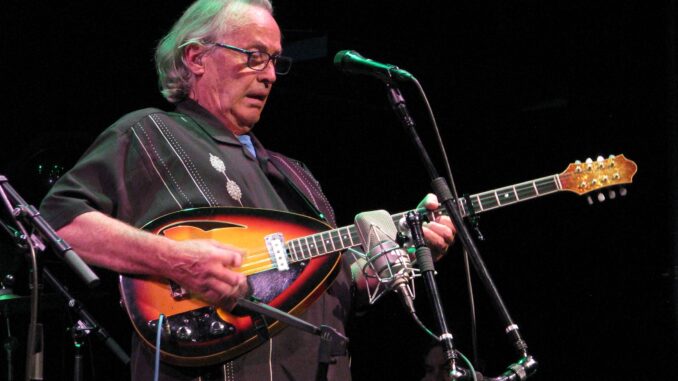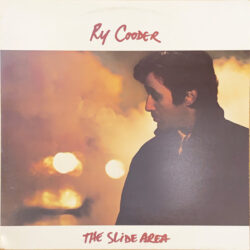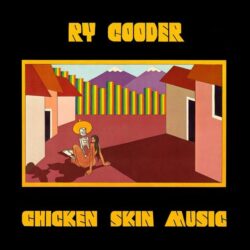
Back in the seventies, Ry Cooder and J J Cale started me on my journey to explore American roots music. At the time, I thought Cooder was recreating the sounds of bygone times with his uncovering of long-lost songs and that Cale was the epitome of back porch dusty Okie music. It took me a while to work out that Cale’s records were heavily engineered and the music heavily processed in the studio to get the exact sound he wanted, and with Cooder, I finally realised that while he may be playing old songs from many genres, his arrangements were all his own and he cheerfully mixed genres.
At the start of the seventies, Ry Cooder was a legendary almost ethereal figure. Those in the know may have heard he had worked with Taj Mahal and Captain Beefheart’s Magic Band as well as the Rolling Stones which was the foundation of the legend, but very few people had heard him actually play, be it live or on record. All this changed when in 1973 he appeared on the Old Grey Whistle Test with his bandana and an acoustic slide guitar. I got a Ry Cooder album as soon as I could after that and it was his 1970 eponymous debut which still has a special place in my musical affections. From that moment I got every new release as well as obviously picking up the couple of early albums I initially missed.
Following Ry has been a lot of fun and he has shone a light on many genres of music to explore. However, like all musicians, he has had to work hard at maintaining a lifelong career. By the mid-seventies, Cooder’s career was building momentum with 1976 gaining sales and publicity in Europe, so much so that a major European tour to support 1976’s “Chicken Skin Music” was arranged and Ry and Warner Brothers had high hopes for the album which mark new highs in Ry’s ability to mix genres and songs.. However, by the early ‘80s, Cooder was beginning to feel frustrated with the album tour album cycle, particularly as while he had built a solid following, it was nothing like that of other successful rock musicians at the time, and it was clear that his albums, while critical successes, had a limited if dedicated audience.
1982’s “The Slide Area” attempted to change Cooder’s approach, as it was largely one genre with 5 of the eight songs written by Cooder with his band. Cooder didn’t record a solo album until 1987’s “Get Rhythm”, as the ‘80s saw Cooder largely reinvent himself as a soundtrack writer before moving into world music in the ‘90s leading to 1997’s “Buena Vista Social Club” phenomenon. In the 200os Ry finally managed to find an approach that allowed him to create story albums with his lyrics against various representations of roots music, starting with 2005’s “Chávez Ravine”.
Can’t Live With It: “The Slide Area” (1982).

To be absolutely honest, I’ve been living with “The Slide Area” since 1982 in the sense that is when I bought the album but I haven’t played it for more years than I care to remember, which is not something I can say about the rest of Ry Cooder’s catalogue. So, what makes this particular recording so different from the rest of his non-soundtrack catalogue ? Well, it definitely isn’t the supporting musicians because he brought his A-team which included Jim Keltner on drums, Jim Dickinson and William D Smith on keyboards, John Hiatt, Willie Green, Bobby King and Herman Johnson, Tim Drummond, Reggie McBride and Chuck Rainey on bass. The music on the album is his, and the band’s, take on the funk rock of the ‘70s and early eighties and can be seen as part of a continuum from 1979’s “Bop Till You Drop” where Cooder explored early R&B and rock & roll, and 1980’s “Borderline” where he continues to mine the R&B of the 50s and 60s and included a John Hiatt song and a song written for B B King by the Crusaders. Despite “Bop Till You Drop”’s sterile production sound, it was the first album to be recorded digitally, it included a wonderful collection of songs that were given new commercial life like ‘Little Sister’ and ‘Go Home Girl’. While “Borderline” didn’t maintain the standard of found songs, it did include some great song finds like ‘Crazy ‘Bout an Automobile’ and ‘Why Don’t You Try Me’, and that is exactly the problem I have with “The Slide Area”; the quality of the songs, with one notable exception, does not match other solo releases.
By the early ‘80s, Cooder was a maturing artist, and while his artist credibility meant that there was little chance of Warner Brothers letting him go, his label was keen to increase his sales which didn’t match the respect in which he was held within the industry. From a personal viewpoint, as he was approaching middle age Cooder had increasing family responsibilities, and the increasing commercial success of some of the artists he had worked with in the ‘60s and ‘70s was a potential source of frustration. “The Slide Area” contains five songs he wrote, sometimes with others, and three covers. As mentioned earlier, the sound was 70s and early 80s rock funk and with the level of his own songs was meant to show a more contemporary Cooder.
The opening track “UFO Has Landed In The Ghetto” was a rare co-write with drummer Jim Keltner who certainly enjoys himself. What follows are the three covers including Dylan’s ‘I Need A Woman’ (unreleased at the time). Any unreleased Dylan song will attract attention but Dylan never managed to get the song to a point where he played it live or recorded it for an album. It was released twice as part of The Bootleg Series. Cooder did rewrite the lyrics to get the song to a point where he felt comfortable singing it. Curtis Mayfield’s ‘Gypsy Woman’ follows which can hardly be described as a found song and the arrangement doesn’t add anything to the song. The one song on the album that bears repeated listening is Carl Perkin’s ‘Blue Suede Shoes’ which does benefit from its funk-rock arrangement. Cooder also works up Willie Dixon’s ‘Which Came First’ from 1967 and records it in a new funky arrangement for the ‘80s. While “The Slide Area” sold well initially, it was in line with the top end of previous album sales, it didn’t break the previous financial model. Cooder didn’t record another solo album until 1987’s “Get Rhythm”, preferring to concentrate on his burgeoning film soundtrack career.
In a sense, “Get Rhythm” is what “The Side Area” could have been if it hadn’t been for the commercial considerations. It is a celebration of rhythm in all its glory and includes various found songs and Cooder’s modern take on a couple of rock & roll classics. It also includes Jim Dickinson’s modern-day classic ‘Across The Borderline’ which he wrote with Cooder and Hiatt. Cooder wrote ‘Going Back To Okinawa’ which only someone with his background in folk could have written. In short, “Get Rhythm” is classic Cooder, something “The Slide Area” isn’t, primarily because of the commercial decisions around its creation, and at the time, Cooder hadn’t managed to develop his songwriting. This changed in the 2000s with his trilogy of California albums documenting his early life in California where he managed to include his storytelling, skills, his arranging skills and knowledge of roots music with the skills he developed as a soundtrack writer. In that sense, “The Slide Area” can be seen simply as an attempt to establish himself as a songwriter before he had fully developed his approach.
Can’t Live Without It: “Chicken Skin Music” (1976).

Ry Cooder is one of those rare artists who has continued to move forward throughout his career, with each phase offering new and interesting music. However, the album that had the biggest influence on my own musical journey and still means a lot to me is “Chicken Skin Music”. I remember looking through the racks on the day it was released and being immediately drawn in by the cover and wondering what magic he had weaved this time. 1974’s “Paradise and Lunch” had been a career-high in that it was sonically rich and mixed the sounds of the 20s, 30s, 40s and 50s with those of today, and Cooder’s guitar maintained enough of a bite for it still to be considered rock music. While “Chicken Skin Music” followed the template of earlier albums of featuring-found songs and more well-known songs in new versions with the arrangements mixing the musical genres of the 20th Century, it brought this approach to a completely new level and brought Tejano and Hawaiian music to a wider audience.
The music on “Chicken Skin Music” can not be considered rock music, it is folk music of the highest order. Flaco Jimenez and his accordion do not appear on every track but his presence pervades the album from the opening track, Leadbelly’s ‘The Bourgeois Blues’ which features Cooder on various stringed instruments, including a bajo sexto and French accordion after he’d had lessons from Flaco Jimenez; Jimenez, with various members of his band, appears on the Jim Reeves number ‘He’ll Have To Go’, Ben E King’s ‘Stand By Me’, and Leadbelly’s ‘Goodnight Irene’ as Cooder puts Jimenez’ music into new musical contexts. The other revelation on “Chicken Skin Music” is the Hawaiian music of Gabby Pahinui and Atta Isaacs. Cooder recorded ‘Yellow Roses’ and ‘Chloe’ in Hawaii and they feature the slack-key guitar of Atta Isaacs and the steel guitar of Gabby Pahinui which shows the cross-pollination with Western Swing. With Cooder on slack-key guitar, they create the Hawaiian music of the 40s and 50s.
Cooder also goes back to the minstrel and medicine show tradition for Pink Anderson’s ‘I Got Mine’. He had covered Blind Alfred Reed on his debut album and he covers his ‘Always Lift Him Up’, but arranged the tune in slack-key style and added a Hawaiian gospel song, ‘Kanaka Wai Wai’ to the arrangement. Bobby King, Terry Evans and Herman Johnson add their gospel harmonies which bring out the gospel in both traditions. Gospel music is featured again with the arrangement of the Mills Brothers 1955 hit ‘Smack Dab In The Middle’, which features James Adams and Cliff Givens, Gospel singers from the 30s and 40s.
Ry Cooder has always recorded albums which are meant to be listened to as a complete set of songs. “Chicken Skin Music” is a fantastic listen through Tejano arrangements of non-Tejano songs, and Hawaiian sounds that look back to the 40s and 50s heyday of Hawaiian music, all held together by gospel music inspired by the sounds of the 30s and 40s. The album’s title comes from the Hawaiian term for music that gives you goosebumps, and that’s what I got when I first heard the album nearly 50 years ago and still do today. Also, the album sent me off exploring Hawaiian and Tejano music which was a trip in itself, as they say.
As a postscript, the tour that Cooder undertook to support “Chicken Skin Music” where he was backed by Flaco Jimenez and his band together with gospel singers Terry Evans, Bobby King, and Ethridge King was recorded and released as 1977’s “Show Time” as he played songs from his career with some new songs, all in Tejano arrangements.



Pull up some dust. Imho is his best solo work to date.
His contribution to Bring the family is excellent.
Little Village and the eponymous release had glimpses of potential.
I saw him on tour with Joachim and his wife with Nick Lowe and the concert was superb. I agree that Ry is a pure artist a born creative that serves his own muse and walks to the beat of his own drum. Long may he prevail.
Thanks, Laurence. As with any artist who has a significant body of work there will always be a variety of opinions as to which is their best album. Ry is that rare type of artist who has managed to maintain their cutting edge right throughout a long career.
Hi Martin, your setting out to explore Ry and J.J.sounds like we were both out there doing it around the same time. I can remember getting that first album and digging around to find out who these mysterious songwriters were (not that easy back then)
Much as I love Chicken Skin Music I still favour Paradise and Lunch,not a fan of the Slide Area but whilst agreeing on the songs on Bop till you drop are great I despise the sound of the album and cannot listen to it at all.
Great to see Ry still keeping busy ,maybe due a slot at Glastonbury, would certainly be better than a recent “Legends” performance.
Thanks, Dave. I must admit to being a bit nostalgic for those early days of life’s musical adventures when we had a sense of wonder about what we would find next. No one can deny that “Paradise and Lunch” is a great album. “Bop Till You Drop” was the first digitally recorded album which explains the jarring sound. I suppose anything is possible but I’m not holding my breath about a Legends slot.
The second side of Ry Cooder’s The Slide Area holds up much better to critical scrutiny than the first side. The songs on side two starting with “Mama, don’t treat..” through to the closing “That’s The Way Love Turned Out for Me” weave the template of what new country and Americana music genres will turn into in the 90s and 00s except that Cooder recorded it in very early 80s. If you pick any contemporary country or blues album made in 81/82 and listen to it, it sounds nothing like The Slide Area.
That’s true, and Jim Keltner had a lot to with the overall sound. However, it is the least listened to non- soundtrack solo album in my collection. I’ve heard a number of musicians say that they can’t simple enjoy music because they are forever trying to workout how a artist has achieved a particular sound which prevents them from simply kicking back with a beer and enjoying the music.
I agree with you that it’s not Cooder’s greatest record. However I always felt not enough people flipped over to listen carefully to side two of that album. The songs on side two are a much stronger set of songs. And I always felt the seeds of the heavier swamp blues guitar sound that was to appear a few years later in Get Rhythm and Little Village were originally planted on The Slide Area album.
And that sound also cropped up in his soundtrack work so he didn’t waste it.